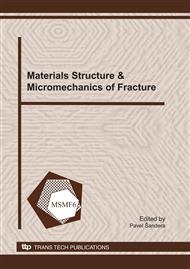p.503
p.507
p.511
p.515
p.519
p.523
p.527
p.531
p.535
Effects of Hydrogen Concentration, Specimen Thickness and Loading Frequency on the Hydrogen Enhanced Crack Propagation of Low Alloy Steel
Abstract:
Crack propagation of SCM440H low alloy steel under varying load is enhanced by absorbed hydrogen. Substantial acceleration of crack propagation rate up to 1000 times was observed compared with that of uncharged material. The role of factors affecting enhanced acceleration was investigated by changing hydrogen concentration absorbed in metal, specimen thickness and loading frequency. Results are as follows. (1) 0.2 mass ppm diffusible hydrogen in metal was enough to cause enhanced acceleration. The predominant fracture mode showing acceleration was quasi cleavage. (2) In the case of thin specimen thinner than 0.8mm, the tri-axiality of stress is weak, and the enhanced crack propagation did not appear. However, the introduction of side-groove to 0.8mm specimen in order to increase the tri-axiality resulted in enhanced acceleration. (3) Lower loading frequency resulted in higher crack propagation rate in cycle domain. The crack propagation rate in time domain was almost constant irrespective of loading frequency. Enough concentration of hydrogen, tri-axiality and low loading frequency resulted in enhanced acceleration of fatigue crack propagation.
Info:
Periodical:
Pages:
519-522
Citation:
Online since:
January 2011
Authors:
Price:
Сopyright:
© 2011 Trans Tech Publications Ltd. All Rights Reserved
Share:
Citation:


